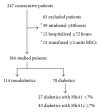Diabetes and hemoglobin a1c as risk factors for nosocomial infections in critically ill patients
- PMID: 24459586
- PMCID: PMC3891611
- DOI: 10.1155/2013/279479
Diabetes and hemoglobin a1c as risk factors for nosocomial infections in critically ill patients
Abstract
Objective. To evaluate whether diabetes mellitus (DM) and hemoglobin A1c (HbA1c) are risk factors for ventilator-associated pneumonia (VAP) and bloodstream infections (BSI) in critically ill patients. Methods. Prospective observational study; patients were recruited from the intensive care unit (ICU) of a general district hospital between 2010 and 2012.
Inclusion criteria: ICU hospitalization >72 hours and mechanical ventilation >48 hours. HbA1c was calculated for all participants. DM, HbA1c, and other clinical and laboratory parameters were assessed as risk factors for VAP or BSI in ICU. Results. The overall ICU incidence of VAP and BSI was 26% and 30%, respectively. Enteral feeding OR (95%CI) 6.20 (1.91-20.17; P = 0.002) and blood transfusion 3.33 (1.23-9.02; P = 0.018) were independent risk factors for VAP. BSI in ICU (P = 0.044) and ICU mortality (P = 0.038) were significantly increased in diabetics. Independent risk factors for BSI in ICU included BSI on admission 2.45 (1.14-5.29; P = 0.022) and stroke on admission2.77 (1.12-6.88; P = 0.029). Sepsis 3.34 (1.47-7.58; P = 0.004) and parenteral feeding 6.29 (1.59-24.83; P = 0.009) were independently associated with ICU mortality. HbA1c ≥ 8.1% presented a significant diagnostic performance in diagnosing repeated BSI in ICU. Conclusion. DM and HbA1c were not associated with increased VAP or BSI frequency. HbA1c was associated with repeated BSI episodes in the ICU.
Similar articles
-
Route of nutrition and risk of blood stream infections in critically ill patients; a comparative study.Clin Nutr ESPEN. 2016 Apr;12:e14-e19. doi: 10.1016/j.clnesp.2016.01.002. Epub 2016 Mar 2. Clin Nutr ESPEN. 2016. PMID: 28531664
-
Pre-intensive care unit intubation and subsequent delayed intensive care unit admission is independently associated with increased occurrence of ventilator-associated pneumonia.Clin Respir J. 2018 Oct;12(10):2497-2504. doi: 10.1111/crj.12944. Epub 2018 Sep 23. Clin Respir J. 2018. PMID: 30015372
-
Impact of dexamethasone on the incidence of ventilator-associated pneumonia and blood stream infections in COVID-19 patients requiring invasive mechanical ventilation: a multicenter retrospective study.Ann Intensive Care. 2021 May 31;11(1):87. doi: 10.1186/s13613-021-00876-8. Ann Intensive Care. 2021. PMID: 34057642 Free PMC article.
-
Diabetes mellitus and community-acquired bloodstream infections in the critically ill.J Crit Care. 2014 Feb;29(1):70-6. doi: 10.1016/j.jcrc.2013.08.019. Epub 2013 Oct 3. J Crit Care. 2014. PMID: 24090695
-
The impact of ventilator-associated pneumonia on the Canadian health care system.J Crit Care. 2008 Mar;23(1):5-10. doi: 10.1016/j.jcrc.2007.11.012. J Crit Care. 2008. PMID: 18359415 Review.
Cited by
-
Is type 2 diabetes mellitus in mechanically ventilated adult trauma patients potentially related to the occurrence of ventilator-associated pneumonia?J Res Med Sci. 2016 Apr 8;21:19. doi: 10.4103/1735-1995.179887. eCollection 2016. J Res Med Sci. 2016. PMID: 27904565 Free PMC article.
-
The association between hemoglobin A1c and all-cause mortality in the ICU: A cross-section study based on MIMIC-IV 2.0.Front Endocrinol (Lausanne). 2023 Feb 15;14:1124342. doi: 10.3389/fendo.2023.1124342. eCollection 2023. Front Endocrinol (Lausanne). 2023. PMID: 36875458 Free PMC article.
-
Systemic Immune-Inflammation Index and Long-Term Mortality in Patients with Stroke-Associated Pneumonia.J Inflamm Res. 2023 Apr 17;16:1581-1593. doi: 10.2147/JIR.S399371. eCollection 2023. J Inflamm Res. 2023. PMID: 37092129 Free PMC article.
-
American Association of Clinical Endocrinology Clinical Practice Guideline: Developing a Diabetes Mellitus Comprehensive Care Plan-2022 Update.Endocr Pract. 2022 Oct;28(10):923-1049. doi: 10.1016/j.eprac.2022.08.002. Epub 2022 Aug 11. Endocr Pract. 2022. PMID: 35963508 Free PMC article.
-
An Elevated Glycemic Gap is Associated With Adverse Outcomes in Diabetic Patients With Community-Acquired Pneumonia.Medicine (Baltimore). 2015 Aug;94(34):e1456. doi: 10.1097/MD.0000000000001456. Medicine (Baltimore). 2015. PMID: 26313809 Free PMC article.
References
-
- Kollef MH. What is ventilator-associated pneumonia and why is it important? Respiratory Care. 2005;50(6):714–721. - PubMed
-
- Joseph NM, Sistla S, Dutta TK, Badhe AS, Parija SC. Ventilator-associated pneumonia: a review. European Journal of Internal Medicine. 2010;21(5):360–368. - PubMed
-
- Payen D, Faivre V, Lukaszewicz AC, Losser MR. Assessment of immunological status in the critically ill. Minerva Anestesiologica. 2000;66(5):351–357. - PubMed
-
- Geerlings SE, Hoepelman AIM. Immune dysfunction in patients with diabetes mellitus (DM) FEMS Immunology and Medical Microbiology. 1999;26(3-4):259–265. - PubMed
LinkOut - more resources
Full Text Sources
Other Literature Sources


